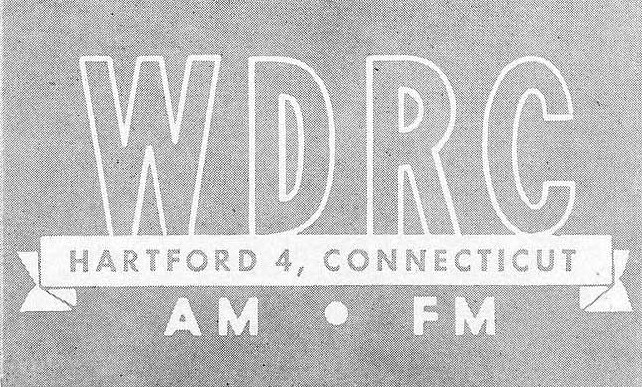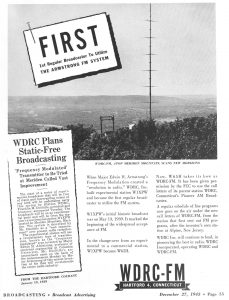By Edward T. Howe
WDRC is the oldest continuously operated commercial radio station in Connecticut that uses both AM (amplitude modulation) and FM (frequency modulation) transmissions. Over several decades, both stations have provided an array of music formats, news/talk programs, and other features to entertain and inform their listeners.
The Rise of Radio
After Nicolai Tesla and Guglielmo Marconi pioneered technical developments in wireless telegraphy during the late 19th century, the early 20th century brought entrepreneurial advances in transmission, amplification, and reception of radio waves in the United States. Based on these developments, unregulated amateur and experimental broadcasts commenced until a ban during World War I. Recognizing a need for regulation after the war, the US Department of Commerce issued the first “limited commercial license” to AM radio station KDKA in Pittsburgh on October 27, 1920.
Radio broadcasting in Connecticut began shortly thereafter, on September 29, 1921, when station WCJ in New Haven received the fifth federal AM radio license. Between April and September 1922, the federal government issued initial licenses for Greenwich’s WAAQ, Hartford’s WDAK, New Haven’s WGAH, and Bridgeport’s WKAX. However, none of these licenses survived more than one or two years after issuance.
CT’s Oldest Commercial Radio Station
Continuous commercial radio broadcasting finally started on December 2, 1922, when the Radio Corporation of New Haven—headed by Franklin M. Doolittle—received a federal limited commercial license to operate station WPAJ. Its first broadcast (on December 10) featured piano music by Florence Morrison, a local music teacher. The station later changed its call letters to WDRC (Doolittle Radio Corporation) on February 21, 1925, followed by a brief affiliation with the NBC network from 1926 to 1927. The New Haven station subsequently moved to Hartford on November 24, 1930, and became an affiliate of the Columbia Broadcasting System, a relationship which lasted thirty years.
On May 13, 1939, Doolittle—influenced by the efforts of Edwin H. Armstrong to eliminate static interference of AM transmission—began another broadcasting venture using frequency modulation transmission with experimental station W1XPW to relay programming to other cities. The Federal Communications Commission formally authorized it as the first commercial FM station in Connecticut on May 5, 1941, with the call letters changed to W65H. Over the next 14 years, the FM station again switched its call letters to WDRC-FM before becoming WFMQ.
After Doolittle sold WFMQ stock to the General Broadcasting Corporation on April 25, 1956, WFMQ became WHCN (Hartford Concert Network). Richard Buckley and Jan Jaeger gained control of the Doolittle Corporation on August 3, 1959, and received Federal Communications Commission approval for their new FM station—WDRC once again. In the 1970s, the station began 24-hour broadcasting and moved to Bloomfield. The Buckley Broadcasting Corporation ownership of WDRC-AM-FM ended when Connoisseur Media bought the station in 2014 and subsequently sold it four years later to Red Wolf Broadcasting.
The Station’s Lasting Influence
During its tenure, WDRC has broadcast both a mix of local programs as well as its share of historic radio events. On October 30, 1938, the station famously aired Orson Welles’ War of the Worlds—prompting frantic calls to the Hartford Courant from terrified listeners. Since then the station has also broadcasted such events as the inaugurations of governors and the University of Connecticut football and basketball games.
Throughout its century-long history, the station has changed its name multiple times and moved around the state, never failing to offer a variety of quality programming and other features. Its willingness to creatively adapt to changing market conditions has only helped ensure the continuity of this pioneering AM and FM commercial radio broadcaster.
Edward T. Howe, Ph.D., is Professor of Economics, Emeritus, at Siena College near Albany, N.Y.










